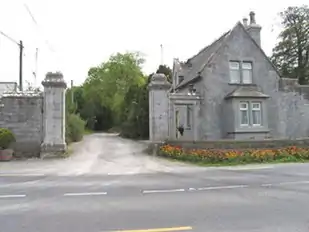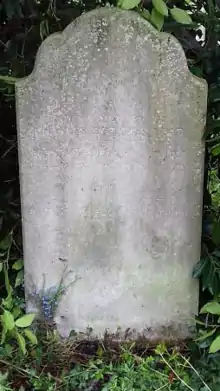Charles Octavius Head
Colonel Charles Octavius Head DSO (30 May 1869 - 1952) was an Irish colonel in the British Army, and author of four books including his autobiography, No Great Shakes. His mansion at Derrylahan was burned during the Irish War of Independence.[1] Head later moved his family to Hinton Hall, Pontesbury in Shropshire. His home in Pontesbury was again destroyed by fire this time accidentally, where much of his library was destroyed making his written works rare.[2]
Charles Octavius Head | |
|---|---|
| Born | 30 May 1869 Derrylahan Park, Rathcabbin, County Tipperary |
| Died | 1952 (aged 82–83) |
| Buried | Cruckton, Shropshire |
| Allegiance | United Kingdom |
| Service/ | British Army |
| Years of service | 1887-1908 1914-1918 |
| Rank | Colonel |
| Unit | 141st Battery of Horse Artillery |
| Battles/wars | First World War |
| Awards | DSO |
Early Life and family

Charles Octavius Head was born on 30 May 1869 at Derrylahan Park, Walshpark, Rathcabbin, County Tipperary to William Henry Head (1809-1888) and his wife Isabella Biddulph (1840-1911). He had three brothers, William Edward, John Henry, and Michael Ravenscroft, and four sisters, Elizabeth, Georgina, Isabella, and Anna.[3] He attended boarding school in Bray, County Wicklow before enrolling in the Royal Military Academy in Woolwich, London in 1885, he graduated as a lieutenant from the academy in 1887.[4]
Head married Alice Margaret Threlfall of Tilstone Lodge, Tarporley, in Cheshire in 1908, they had three children, Elizabeth, Isabel, and Michael.[5]
Military career
Head served in India, China, and South Africa before returning to Ireland in 1905 and was assigned to the 141st Battery of Horse Artillery at Cahir, County Tipperary. He initially retired from the Army in 1908 but re-enlisted in 1914 after the commencement of WWI where he fought in numerous important battles including the Battle of the Somme. Head retired for good after WWI ended.[4] He was awarded the China Medal for his service, and was awarded the Distinguished Service Order in the 1917 New Year Honours list.[6]
Later life

After he retired from the army at the end of WWI he settled into a life of farming back home at Derrylahan. He farmed the substantial estate which was a mixture of good pasture and woodlands. The house was built by his father in 1862 at the cost of £15,000 and was designed by the famous architect Thomas Newenham Deane.[4] In Tipperary, he served as the local justice of the peace.[6]
The War of Independence in Ireland which began in 1919 threatened the stability of the Anglo-Irish families such as the Heads and the house at Derrylahan was burned by the IRA on 1 July 1921.[7] Head moved his family to England and settled at Hinton Hall in Shropshire. While in England he wrote four books, his autobiography No Great Shakes, and three military books, A Glance at Gallipoli (1931), Napoleon and Wellington, and The Art of Generalship: Four Exponents and One Example (1929). In 1936 an accidental fire at Hinton Hall destroyed much of his personal papers including much of his printed material.[2] His 1929 book, The Art of Generalship, included an overview of Duke of Wellington's military career, and draws comparisons between the Battle of Salamanca and generalship in WWI.[8] His account of his experiences in the Somme have been used to reassess elements of the British campaign and tactics in comparison to the French.[9] In A Glance at Gallipoli Head was seen to reopen and critically examine the controversy regarding the military tactics employed in Gallipoli.[10][11]
Legacy
Head's son Michael was a race car driver for Jaguar and was father to Sir Patrick Head former head of engineering at Williams Grand Prix Engineering. Micheal's daughter Sara Day is an author whose works include Coded Letters, Concealed Love, and The Larger Lives of Harriet Freeman and Edward Everett Hale.[12]
References
- O'Meara, Gerard (2016). Lorrha People in the Great War. pp. 100–112. ISBN 978-0-9933557-0-7.
- "Birmingham Gazette". 7 September 1950.
- Burke, Bernard; Fox-Davies, Arthur Charles (1912). A genealogical and heraldic history of the landed gentry of Ireland. London: Dalcassian Publishing Company. p. 305.
- Head, Charles Octavius (1943). No Great Shakes. Gateshead-On-Tyne: Northumberland Press.
- "Family History". Carrigoranblogpost.com. Retrieved 10 November 2020.
- . . Dublin: Alexander Thom and Son Ltd. 1923 – via Wikisource.
- "The Kings County Chronicle". 7 July 1921.
- Partridge, Michael (1990). The Duke of Wellington, 1769-1852 : a bibliography. Westport, CT: Meckler. p. 150. ISBN 0-88736-297-4. OCLC 22110585.
- Stamp, Gavin (2010). The memorial to the missing of the Somme. London: Profile. pp. 22, 192. ISBN 978-1-84765-060-3. OCLC 666953890.
- "A famous controversy is reopened by Colonel C. 0. Head". The Spectator Archive. 27 Jun 1931. Retrieved 2020-11-12.
- Johnston, Major E.S. (1932). "Head, Lieut.-Colonel C.O. - A glance at Gallipoli. London, 1931". Command and General Staff School Quarterly: Review of Military Literature. 11.
- O' Meara, Gerard (2016). Lorrha People in the Great War. p. 109. ISBN 978-0-9933557-0-7.